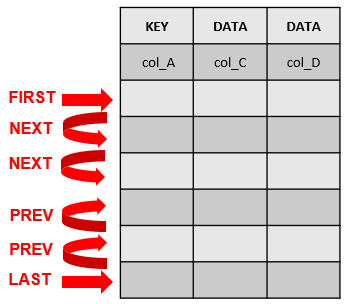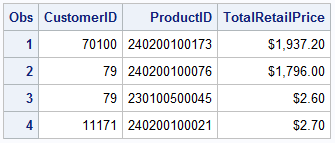Using Hash Iterator Objects
What Is a Hash Iterator Object?
A hash
iterator object is associated with a hash object, enabling
you to retrieve hash object data in either forward or reverse key
order. Think of the hash iterator object, or hiter, as an ordered
view of a hash object.
Figure 12.4 Hash Object Iterator

Note: Declare the hash object before
defining the hash iterator object.
In the following example,
the Certadv.Orderfact table is loaded into the hash object Customer.
The hash object Customer then feeds into the hash iterator object
C. Notice that there is a DECLARE statement for the hash object Customer
and a DECLARE statement for hiter (hash iterator) object C. The hash
object name must be enclosed in quotation marks when it is referenced
in the DECLARE statement for the hash iterator object.
declare hash Customer (dataset: 'certadv.orderfact', ordered: 'descending'); ...statements.. declare hiter C('Customer');
The ORDERED argument
in the hash object is not controlling the sort order of the hash object.
The ORDERED argument controls the sort order of an output table only
if an OUTPUT method is used in the hash object or the sort order of
a hash iterator object that points to the hash object.
Declaring and Defining a Hash Object and a Hash Iterator Object
The hash object loads
the data in the order in which it occurs in the data set. The ORDERED
argument specifies retrieving data from the hash object by descending
order of key values.
declare hash Customer(dataset: 'certadv.orderfact', ordered: 'descending');
The DEFINEKEY, DEFINEDATA,
and DEFINEDONE methods execute. The key values are not returned to
the PDV.
customer.definekey('TotalRetailPrice', 'CustomerID');
customer.definedata('TotalRetailPrice', 'CustomerID', 'ProductID');
customer.definedone();
The second DECLARE statement
defines the hash iterator object, C. It points to the hash object,
Customer, whose data is in descending order of key values.
declare hiter C('customer');
Retrieving Hash Object Data with the Hash Iterator Object
Hash iterator methods
are operations that are performed on a hash iterator object using
dot notation. The FIRST and NEXT methods read data in forward key
order. The LAST and PREV methods read data in reverse key order.
|
Method
|
Description
|
Syntax
|
Example
|
|---|---|---|---|
|
FIRST
|
Returns the first data
value in the underlying hash object.
|
object-name.FIRST(
);
|
declare hiter C('customer');
<more SAS code>;
C.first();
|
|
LAST
|
Returns the last data
value in the underlying hash object.
|
object-name.LAST(
);
|
declare hiter C('customer');
<more SAS code>;
C.last();
|
|
NEXT
|
Returns the data components
in key order.
Note: If you use the NEXT method
without the FIRST method, it returns the first item in the hash object.
|
object-name.NEXT(
);
|
C.first();
<more SAS code>;
C.next();
C.next(); |
|
PREV
|
Returns the data components
in reverse key order.
|
object-name.PREV(
);
|
C.prev(); |
object-name
specifies the name
of the hash iterator object.
-
The FIRST method returns the first data item in the hash object. The LAST method returns the last data component in the hash object.
-
You can use the NEXT method to return the next data component in the hash object.
-
Use the PREV method iteratively to traverse the hash object and return the data components in reverse key order.
Note: The PREV method sets the
data variable to the value of the data component so that it is available
for use after the method call.
Example: Using the Hash Iterator Object
Suppose you need to
identify which two customers ordered the most and least expensive
items. You can use the hash iterator object to retrieve the data in
either ascending or descending key order to efficiently identify these
four customers.
data work.topbottom;
drop i;
if _N_=1 then do;
if 0 then set certadv.Orderfact (keep=CustomerID
ProductID TotalRetailPrice);
declare hash customer(dataset: 'certadv.Orderfact',
ordered: 'descending');
customer.definekey('TotalRetailPrice', 'CustomerID');
customer.definedata('TotalRetailPrice', 'CustomerID',
'ProductID');
customer.definedone();
declare hiter C('customer');
end;
C.first();
do i=1 to 2;
output work.topbottom;
C.next();
end;
C.last();
do i=1 to 2;
output work.topbottom;
C.prev();
end;
stop;
run;
Output 12.2 PROC PRINT Output of Work.TopBottom

Last updated: October 16, 2019
..................Content has been hidden....................
You can't read the all page of ebook, please click here login for view all page.
